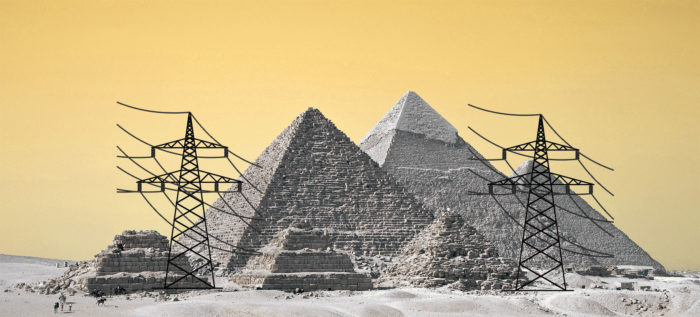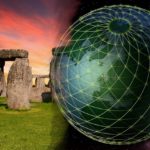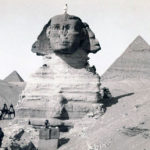
When You Break Down The Theory, The Great Pyramid Of Giza Really Could Have Been A Power Plant From Antiquity!
- By
- September 8, 2016
- September 28, 2021
- 6 min read
- 3
- Posted in
- Conspiracy Theory Analysis, Technology
Many people have theorised about the Great Pyramid of Giza and what its purpose or function truly was. One researcher in particular, Christopher Dunn, has studied and researched the megalithic structure for decades, writing several papers and books on the subject. Dunn firmly believes that the Great Pyramid of Giza was nothing less than an ancient power plant that provided Ancient Egypt with electricity. Not surprisingly his theory was rejected by mainstream historians and researchers, but there are many, who operate on the fringes of the subject who are more receptive to his ideas.
Some for example, in particular Ancient Astronaut theorists, accept the power plant theory and even suggest that the pyramids are the result of alien technology, built long before the Ancient Egyptians. One such theorist, Zecharia Sitchin, theorised in his Earth Chronicles book series, in particular the third instalment, “The Wars of Gods and Men”, that the Pyramids were built by a race of aliens called the Anunnaki who had come to Earth hundreds and thousands of years ago.

Were the Pyramids of Giza really an ancient power station?
Others maintain that the huge structures were put together by the survivors of Atlantis – the last example of technology from the ancient world. Renowned early twentieth century psychic, Edgar Cayce, who allegedly had visions of Atlantis, told of how the Atlanteans had learned to utilise the power of crystals as well as the harnessing of power from the Earth itself.
While each of those theories are to be delved into another time, if Dunn’s own theory is correct, then it would open up the real possibility that the ancient world, at least at one time, did indeed have power and technology beyond what mainstream historians have given them credit for. Correct or not, most people, even those in the mainstream, accept that the Pyramids were unlikely used as tombs as has long been thought, and few can deny Dunn’s theories are fascinating if nothing else.
So do they stack up? When looked at in a little more detail, as speculative as they are, the idea that the Pyramid of Giza was an ancient power plant begins to sound a little less crazy than you might think.
Contents
Extensive Use Of Particular Limestone And Granite
The Great Pyramid was encased with white tufa limestone [1] that was packed so tightly together not even a blade of grass could be placed between them. This particular limestone has high insulating properties [2] and perhaps more importantly does not contain any traces of magnesium, meaning it will not conduct electricity.
It was theorized by Dunn that this material was used precisely because of this, and that it would have acted as an insulator around the Pyramid. This would have prevented electricity from escaping from inside the structure uncontrollably. The dolomite limestone used on the inner casing of the pyramid contains traces of crystals and other conductive metals. [3] These properties allowed power to be “transferred” at its maximum effect.
In modern-day electrics, conducting materials and insulating materials are used in conjunction with each other, and Dunn argued how they had been used here was not coincidence, and in fact, showed flawless design on the part of the builders.
Inside the pyramid, granite is used within the King’s Chamber, the Queen’s Chamber and the Grand Gallery, [4] as well as in the shafts that connect them all. There are also several granite “tombs” that have been discovered at various locations – although there is no evidence that these tombs were ever used as such and are, according to Dunn, more likely, conductors.
This particular granite was found to have a make-up of fifty-five percent silicon-quartz crystal, and has radioactive properties that can ironize the air around it, particularly when they resonate, which sound testing conducted in the room suggests they do when a “pulse” is created and harnessed. Their positioning inside the King’s Chamber in particular is such that it appears they were not added to simply provide extra strength or support. They appear to have been positioned in such a way so as to amplify and increase the resonance of the room.
Furthermore when Dunn inspected the Serapeum Sarcophagus he was astounded not only by the perfect flatness of the surface, but how each corner was a perfect square to the last 0.001 inch. This, he suggested, could only be achieved through the use of precise and electrically powered tools. He stated that the proposed method of how the Ancient Egyptians would shape granite by simply bashing it with a small ball of dolerite simply wouldn’t produce the levels of precision that were on display throughout the Great Pyramid.
It was also noted by Dunn, that in his opinion, these “sarcophaguses” were built, fashioned, and positioned to act purely as energy conductors.
Water Erosion Inside The Pyramid
While there are many reasons that the Pyramids would be built next to a vast and plentiful water supply, Dunn argues that the main reason was to use the water from the Nile inside the pyramid to assist in producing energy as it would be used in any modern-day power plant.
The Ancient Egyptians were proficient at reading the water levels of the Nile, as well as employing sophisticated irrigations, and the ability to dam and run water to a desired place. What’s more, a discovery made under the Great Pyramid would appear to reinforce this theory somewhat.
As well as evidence suggesting extensive water erosion being found inside the pyramid, particularly in the King’s chamber, but there has also been discovered a subterranean chamber – itself awash with distinct signs of extensive water erosion.
This subterranean chamber has been theorised to essentially be a hydraulic pump system, which was intentionally flooded so as to create a “pulse” and force its way to the King’s Chamber via the main shaft. This pulse would then cause the King’s Chamber to resonate, with the aforementioned granite beams in place to take advantage of this and begin converting the energy into power.
Evidence of “Repeated” Chemical Reaction in Shafts and Chambers
During research of the Queen’s Chamber, it seemed quite apparent to Dunn that a “chemical reaction” took place within this part of the pyramid. There was a “salt” residue upon the walls which suggested this reaction was repeated many, many times.
This, combined with its location below the King’s Chamber suggested that the aim was to produce hydrogen in the Queen’s Chamber, which would then travel upwards and react with other chemicals and energies.
In the shafts that led into the chambers, as well as in the chambers themselves, were found hydrated zinc chloride and dilute hydrochloric acid. According to Dunn, these chemicals would have been released down the relevant shafts, where they would meet in the Queen’s chamber, with the reaction essentially creating electrical energy.
When the iRobot was released to explore the Gantenbrink Door and what was behind it in 2002, most onlookers saw simply another door with broken hooks on it. However, Dunn argued that this appeared to be further proof of the Pyramid being used to produce energy, and that the hooks were in fact the remnants of a type of plug – complete with anode and cathode.
Dunn stated that one of the hooks – the cathode – had evidence of electroplating and was coated in copper. The other hook, which Dunn stated was the anode, appeared to have a white substance on it. This, he believed, was due to continued exposure to the zinc.
Many Egyptologists have speculated that sound or pulse technology was used to harness the natural vibration of the earth and that the Great Pyramid’s precise location, as well as its location to other similar structures around the world, demonstrates that cultures living in ancient times possessed knowledge of how to achieve this. In modern terms, this is only relatively recently being studied and developed in a serious but still limited way.
Dunn also sites particular crystal linings within certain shafts within the structure that act as a way of resonating the vibrations so to harness the energy, as well as the presence of filters in certain locations that allow only the desired frequency to enter certain chambers.
The Grand Gallery
When Dunn was allowed to film inside the Grand Gallery during one of his field investigations, something that had not been allowed previously, he discovered that it was also made of granite and not limestone as had been thought until then. The granite would be better suited if the purpose of this room was to be the central point of a power source, which Dunn now firmly believed it was.
This discovery all but proved to him that his theory was correct. Even more so when he noticed scorch marks at strategic positions throughout the room, suggesting that “connections” had been present here, and that a reaction with a great source of heat had occurred. When he traced an imaginary line from these scorch marks he found that they all seemed to head towards a center point in the middle of the room.
Once a detailed study was conducted inside the Great Gallery, there appeared to be obvious evidence of intense heat or blast that had taken place there – almost as if there had been a powerful explosion. Dunn believed there had been.
He explained that in his opinion, the reason the Great Pyramid was ultimately sealed tight was not to preserve the riches and the bodies of the dead but to keep trapped inside the Pyramid in the aftermath of a horrific explosion. Interestingly, if indeed Dunn’s theory is correct, it would be similar to how Chernobyl was sealed in an impenetrable shell following the nuclear disaster in 1986.
Ultimately, only further study will prove this theory one way or the other, but if these magnificent structures’ purpose was to act as a power station way back in antiquity, then it would force us to have to not only re-evaluate the past but re-write it.
References
| ↑1 | The Giza Pyramids: A History of Wireless Electricity Transmission Validated by Today’s Science, Tamer Youssef and Prof. Khaled Elleithy https://scholarworks.bridgeport.edu/xmlui/bitstream/handle/123456789/565/The%20Giza%20Pyramids%20-%20A%20History%20of%20Wireless%20Electricity%20Transmission%20Validated%20by%20Today%E2%80%99s%20Science%20(FRD%20-%20Poster).pdf?sequence=3 |
|---|---|
| ↑2 | Archaeomineralogy, George Rapp, ISBN 9783540 785941 (page 256) |
| ↑3 | The Great Pyramid Of Giza: A Tesla-like Power Plant Built Thousands Of Years Ago?, Ancient Code https://www.ancient-code.com/great-pyramid-giza-tesla-like-powerplant-created-thousands-years-ago/ |
| ↑4 | Forbidden History: Prehistoric Technologies, Extraterrestrial Intervention, and the Suppressed Origins of Civilization, J. Douglas Kenyon, ISBN 9781591 430452 (Behind The Pyramid’s Secret Doors, Christopher Dunn page, 263-269) |
Fact Checking/Disclaimer
The stories, accounts, and discussions in this article may go against currently accepted science and common beliefs. The details included in the article are based on the reports, accounts and documentation available as provided by witnesses and publications - sources/references are published above.
We do not aim to prove nor disprove any of the theories, cases, or reports. You should read this article with an open mind and come to a conclusion yourself. Our motto always is, "you make up your own mind". Read more about how we fact-check content here.
Copyright & Republishing Policy
The entire article and the contents within are published by, wholly-owned and copyright of UFO Insight. The author does not own the rights to this content.
You may republish short quotes from this article with a reference back to the original UFO Insight article here as the source. You may not republish the article in its entirety.





3 Comments
UFO Insight does not take responsibility for the content of the comments below. We take care of filtering profanity as much as we can. The opinions and discussion in the comments below are not the views of UFO Insight, they are the views of the individual posting the comment.
Newest comments appear first, oldest at the bottom. Post a new comment!
I think the Great Pyramid was a machine designed to make rain (control the weather). I agree with Steven Myers (and Edward J. Kunkel) that the Great Pyramid has a water pump system. I agree with Dunn that electricity was probably involved. Providing water to the machine was needed as a design requirement. There would be no need to pump water if it fell from the sky consistently.
I think that the Great Pyramid was built using water locks and the Great Pyramid’s purpose was to pump water.
Very interesting read my question is if they were producing hydrogen is it possible that they were trying to split the hydrogen atom hence the explosion in the grand Hall and radioactive properties still evident today